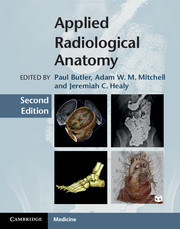Chapter 16 - The lower limb
from Section 3 - Upper and Lower Limb
Published online by Cambridge University Press: 05 November 2012
Summary
Plain radiography
Plain radiography demonstrates osseous anatomy and provides some detail of the soft tissue anatomy.
Cross-sectional imaging
CT
Multi-slice CT allows high-resolution 3D reconstructions of the lower limb that enable exceptional visualization of the bony anatomy. Soft tissues including muscles, tendons and joints can also be identified but these are optimally assessed with sonography and MR imaging.
Sonography
Sonography allows high spatial resolution and dynamic imaging of the soft tissues not obscured by osseous structures. It is particularly optimal for visualization of small and superficial structures (ligaments, tendons) as well as muscle compartments and the neonatal/infant hip.
MRI
MR imaging offers high contrast resolution imaging of the musculoskeletal anatomy. Intra-articular structures are optimally assessed on MR arthrography.
The pelvis
Bone anatomy
Adult pelvis
The pelvic bone is composed of three parts; the ilium, ischium and pubis. These meet at the triradiate cartilage, seen as a lucency within the acetabulum in the immature skeleton (Figs. 16.1– 16.3).
- Type
- Chapter
- Information
- Applied Radiological Anatomy , pp. 319 - 365Publisher: Cambridge University PressPrint publication year: 2012

